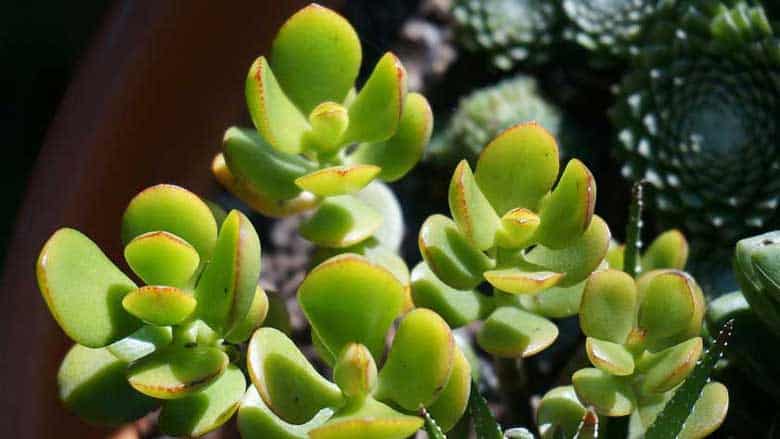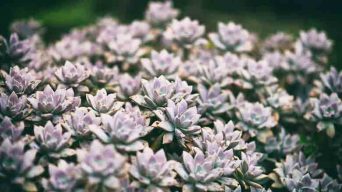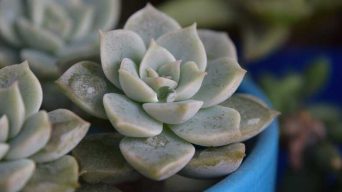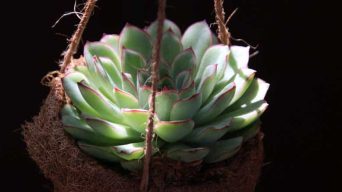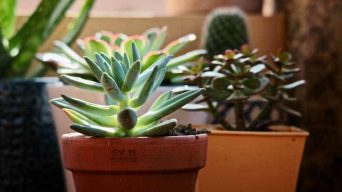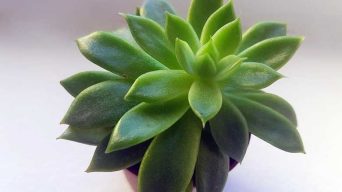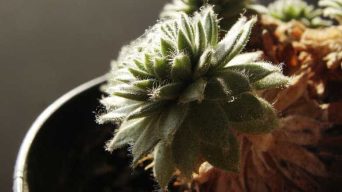There are many varieties of succulents, and they all have different needs. Some need sun, some need shade, some like wet soil, and others like it dry.
If you want to grow your succulent collection quickly, I’ve compiled a list of the fastest-growing succulents and some helpful tips to make them grow even faster.
These plants will help make any space look beautiful in no time at all.
11 Fast Growing Succulents
Aeonium Arboreum (Purple Rose Tree)
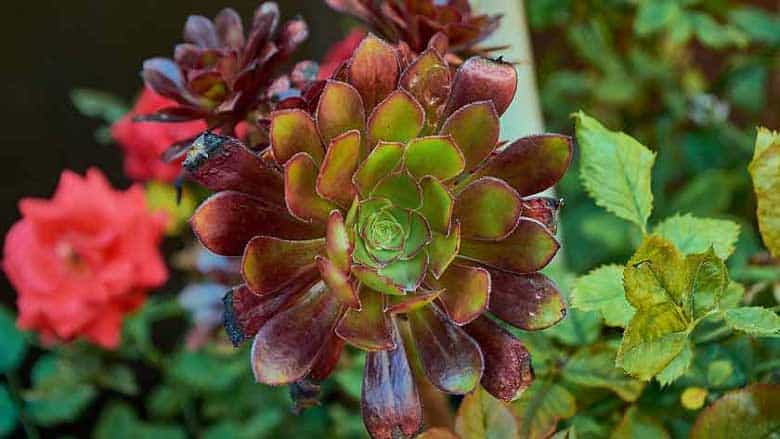
Aeonium arboreum (commonly referred to as the Purple Rose Tree) is a fast-growing succulent.
It’s native to Madagascar. Its name has an array of purple petals that make for dense clusters at maturity, often used as ground cover or landscaping plants.
Aeonium arboreum can grow up to 10 feet tall, with leaves reaching 2ft long each year.
They’re considered deciduous because their foliage dies down during winter months before being replaced by new growth come springtime.
Aeonium arboreum (Purple Rose Tree) can be propagated from leaf cuttings or seeds but is more often propagated by dividing larger clumps.
This succulent grows well in containers with good drainage and should be watered about once a month. They are drought-resistant plants that can tolerate wetter environments as long it’s not submerged for extended periods.
Crassula Perforata (String of Buttons)
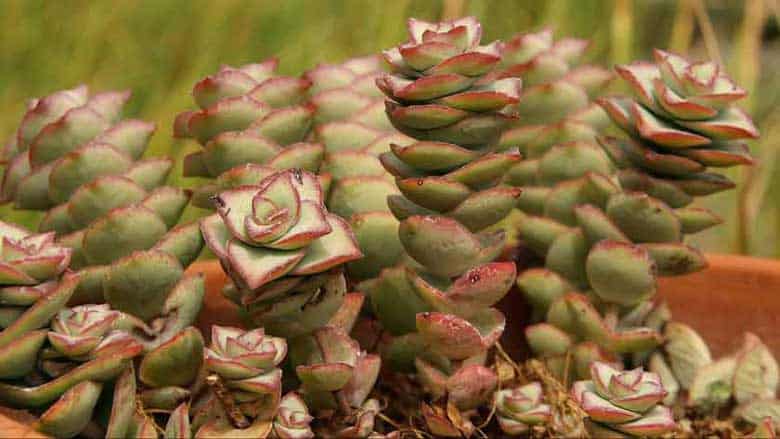
This succulent is also known as the String of Buttons for its distinct cut leaves and is a fast-growing succulent.
The Crassula Perforata plant can grow up to 10 inches in height and spread 2 feet wide. It prefers bright light but will tolerate low-light environments.
The leaves are arranged in rows with distinctive perforations between them, giving the plant its common name, which aptly describes this stringy form.
Their notable features make it so interesting to grow indoors or outdoors, and are perfect for container gardening.
Crassula perforata (String of Buttons) can be easily propagated by leaf or stem cutting.
Keep a String of Buttons plant in direct sunlight until it forms its roots. Transplant outdoors once the temperature stays above 50 degrees Fahrenheit during daylight hours (at least six months).
The leaves can be trimmed to shape under bright light, but do not trim more than one-third at any given time, as this will affect the growth rate, which is already fast for these plants!
These succulents are naturally drought tolerant.
They should only need watering about every two weeks when grown indoors.
They should have moderate-bright indirect sun exposure from an east-facing window, where there’s no intense summer heat that might cause them stress.
Crassula Sarmentosa
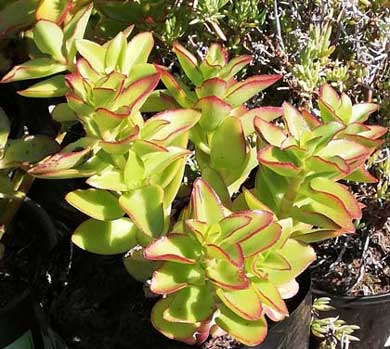
The Crassula Sarmentosa (commonly known as the comet) is a fast-growing succulent that thrives in low-light and humidity conditions.
These plants grow best indoors, so be sure to include them in your greenhouse or sunroom during the winter months!
Crassula sarmentosa grows quickly and is generally pest-resistant. However, these plants do require a lot of water and fertilizer. Be sure to check the soil daily and water when it feels dry.
The Crassula Sarmentosa also prefers a hot, humid summer climate, so be careful not to overwater in the winter months.
Crassula sarmentosa can be propagated by cuttings in the summer months.
Just be sure not to overwater during the winter season if you’re looking forward to propagating this species with clippings again next year’s growing season.
Crassula Ovata (Jade Plant)
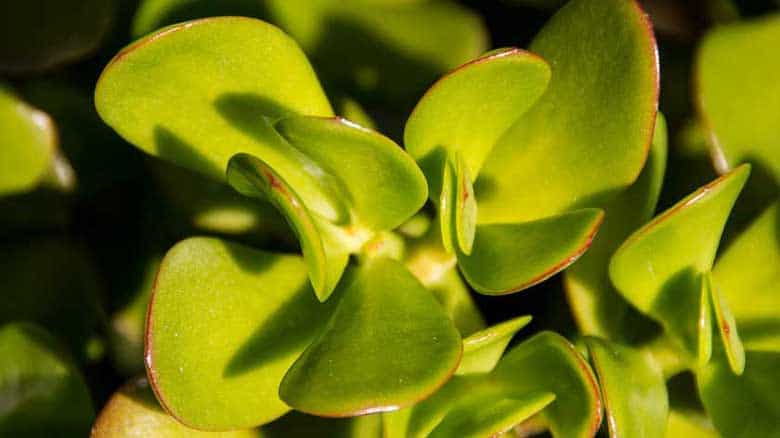
Crassula Ovata, more commonly called the Jade Plant, has been a symbol of good luck and prosperity for centuries.
In its native country China, this plant was seen in ancient times to cleanse households from evil spirits and bring peace with nature.
When placed outside near windows, they would prevent lightning strikes by absorbing any negative energy coming their way!
These plants are also distinguished due to their resistance to drought conditions, making them an ideal choice if you live somewhere where water isn’t always available.
The Crassula Ovata can grow up to 12 inches yearly, so don’t forget those regular watering sessions.
The Jade Plant can be propagated by taking cuttings from a healthy mother plant. If you want more instant gratification, try rooting them into small cups filled with perlite and some water.
The roots should form nicely after about two weeks. Still, it is vital for the containers that hold your succulent cutting to have enough drainage holes.
Echeveria Elegans
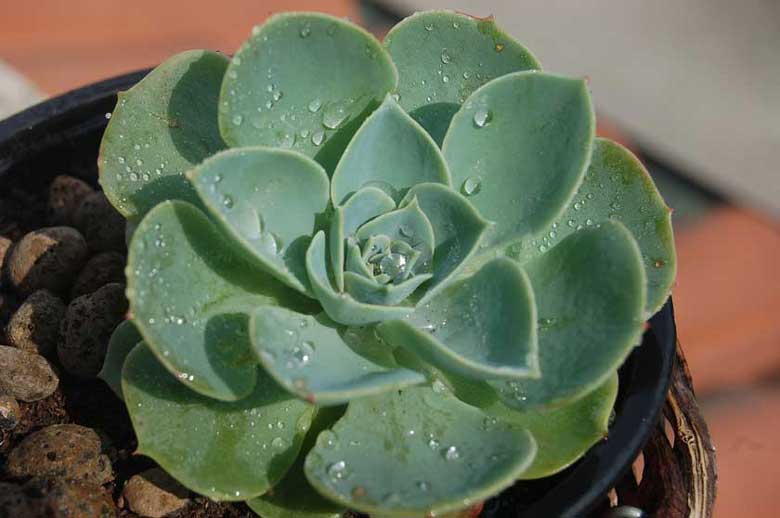
The Echeveria elegans plant is a succulent that can grow up to one feet in height. Its thick, fleshy leaves and stems thrive with just the right amount of sunlight exposure.
The Echeveria plant is a succulent type known for its large size and fast rate of growth.
These Echeveria species are also known as “sunshine” or “brightness” because they prefer lots of direct sun but need water moderately well.
It can easily be propagated through cuttings, making it perfect for people who are new to succulent gardening or want more of this hardy species at home.
The flowers, on the other hand, bloom best during the summer months, so you’ll have to wait until then if you’re looking forward to seeing these gorgeous blooms!
Kalanchoe Daigremontiana (Mother of Thousands)
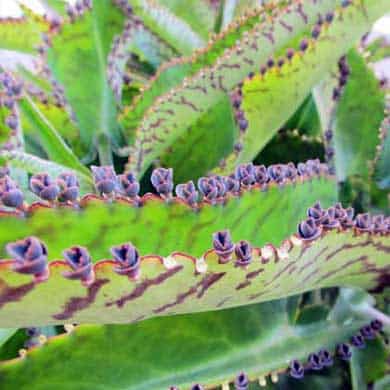
The Kalanchoe daigremontiana is a fast-growing succulent. It can quickly cover any area of the ground or stairs and make an interesting decorating piece to compliment your garden space.
These plants are also known as Mother of Thousands because they rapidly propagate by producing pups which will eventually grow into their own plant when enough roots have developed.
It prefers bright light but not direct sunlight and has an affinity with plants such as cacti or other hardy varieties.
The Kalanchoe daigremontiana can be propagated by dividing it into smaller sections and planting them in a pot.
It is recommended to use a pot with good drainage and keep the soil moist.
Kalanchoe Fedtschenkoi (Aurora Borealis)
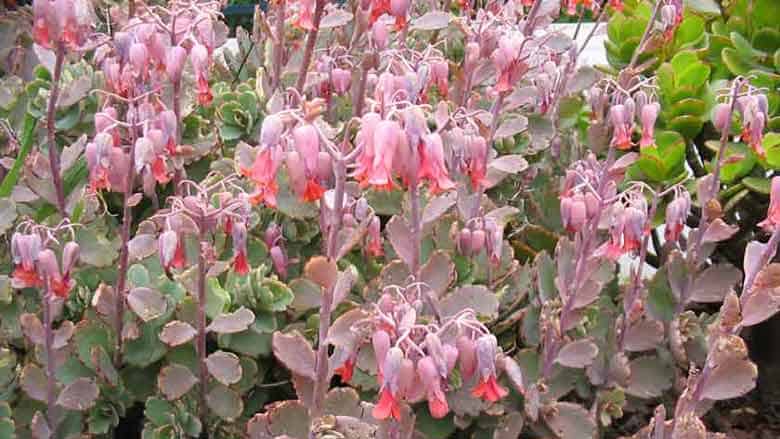
The Kalanchoe fedtschenkoi will grow to be up to two feet tall and have light green leaves with beautiful red bracts arranged like petals on the flowers.
It prefers a location that receives direct sunlight and can tolerate more than one soil type as long is well-drained.
It does not need much water during the winter months, while summer watering should depend upon how hot your climate gets!
It propagates by taking stems cutting in early spring or any time after the succulent leaf fall when new growth begins again for maximum success rate.
The plant requires some patience before bearing blossoms from which you’ll get seeds if desired.
Sedum Makinoi
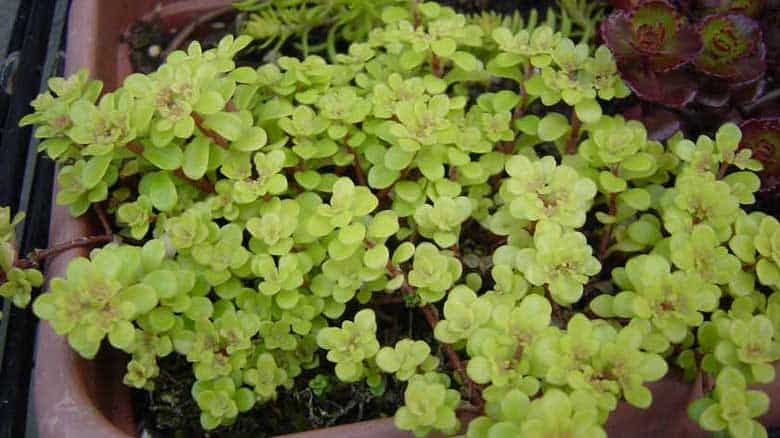
Sedum makinoi is a fast-growing succulent that can grow very quickly. It has an unusual shape with spiky leaves and small white flowers. This plant will be about three feet tall when it’s mature, so make sure you have space before planting as it needs plenty of room to spread out.
These succulents need plenty of sun so make sure they are planted in an area where there are lots.
It also likes dry soil, while most other varieties like wetter soils.
This variety has been known as drought-resistant. You won’t have much watering or maintenance on your hands if these plants become adequately established from their start point.
They grow well indoors, even though many people think that because sedums love hot weather and don’t do very well when temperatures drop below 50 degrees Fahrenheit.
Sedum Rubrotinctum (Jelly Bean Plant)
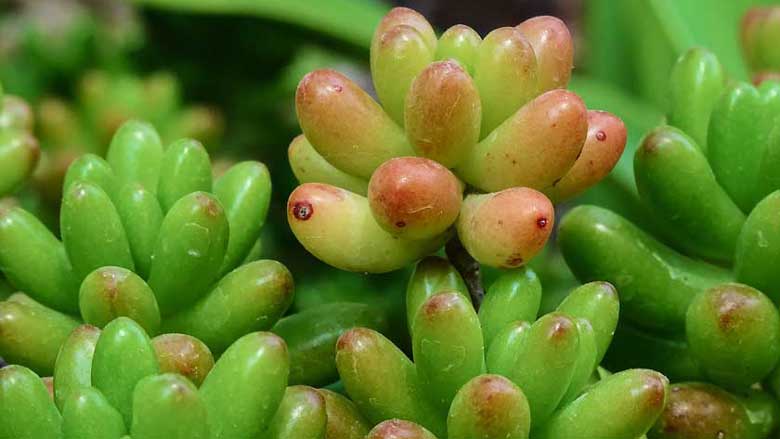
The Jelly Bean Plant is a fast-growing succulent with beautiful, vibrant green leaves.
It’s common for the plant to grow anywhere from two inches in height up to about three feet tall and wide. But this particular specimen can also be found growing at not more than eight inches.
With its reddish leaves and yellow flowers, the jelly bean plant is an excellent addition to any garden.
It’s an all-purpose succulent that can be used for formal gardens or even rockeries. They are an easy to grow indoor plant because they produce bountiful blooms in just six months!
It grows best when it’s planted with other low-maintenance plants like cacti since Sedum rubrotinctum thrives without much water at all.
It thrives in full sun all year long but can tolerate partial shade as well. This hardy little guy has been known to survive years of drought with no watering, so don’t be tempted by the seductive scent of its flowers.
Let them go dry before adding more water unless you want your other plants dying too!
The Jelly Bean Plant can be propagated by dividing the plant into sections with a sharp knife in spring and then replanting them.
Senecio Haworthii (Cocoon Plant)
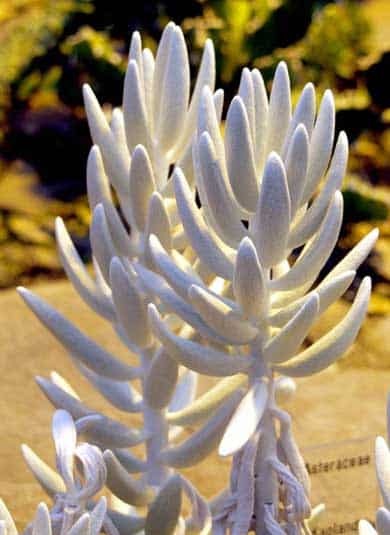
The Senecio Haworthii is a fast-growing succulent with small, green leaves.
If you’re looking for an unusual house plant that won’t take up too much space and can thrive in low-light conditions, this might be a perfect choice!
The Cocoon Plant is an interesting succulent that often grows in a ball shape with multiple leaves on top of each other.
The small, round green, or dark red plants are found worldwide and only require moderate watering to grow well!
It does great indoors as the soil can dry out quickly due to its natural habitat being rocks among grasses outside where there isn’t much moisture available.
When light levels drop significantly inside in the winter months, you may need artificial lighting if your space doesn’t receive enough UVB rays from sunlight.
Senecio haworthii can be propagated by cuttings or stem offsets from mature plants.
This plant is one of the fastest-growing succulents, so you can expect your new baby to grow quickly.
Senecio Rowleyanus (String of Pearls)
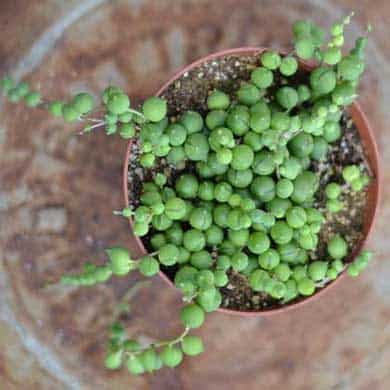
Some succulents grow so quickly that you can watch them go from seedlings to mature plants in just a few weeks.
This is the case with Senecio Rowleyanus, also known as String of Pearls or snake plant, for its appearance and growth habit.
The String of Pearls grows at an average rate between 2-3 feet per year.
It flowers twice yearly during springtime, followed by autumnal blooms when it reaches maturity around 18 inches tall.
This species requires little water due to its low moisture requirement (less than 11 cm) but does require sufficient drainage, which should be provided through organic soil such as peat moss mixed with sand.
The String of Pearls is one the fastest growing succulents that will not only look great in your home but also help make it feel like summertime all year round!
How To Make Succulents Grow Faster
Remove the Plant’s Old Leaves
If your succulent is looking a little shaggy, you can remove its old leaves.
You don’t want to make this too regular of an occurrence to stunt the plant’s growth.
But every once in a while should be fine and might give new ones more time or light for their development!
Water Your Succulent When the Soil Is Dry
The best way to make your succulent grow faster is with water. Succulents like to be watered when the soil is dry.
If you’re worried about your succulent not having enough water, take a peek at its leaves. If they are curling up or starting to droop down, then it needs some watering.
Make Sure Your Succulents Have Enough Light
If you want to grow your succulent faster, make sure it has enough light. Make sure they have the right amount of light. You can check the amount of light your succulent is getting by feeling how warm its leaves are.
If they’re too hot, then there might not be enough sun, and you should move them to a new spot with more sunlight.
As always, make sure the plant sits happily in one spot for a while without moving it as much. This will help them not to get too used to this new area.
Place Your Succulents in a Warm, Humid Environment (But Not Too Hot)
Succulents need to be in a warm, humid environment. Make sure you don’t put them somewhere that is too hot or dry!
Dry air can cause succulent leaves and stems will start drooping down from dehydration while being exposed for extended periods.
High temperatures may give it sunburns which won’t help your plant grow faster at all.
It might even eventually kill off some parts.
Repotting May Be Necessary
If you have a succulent that is growing quickly, it may be time to repot them.
This will help their root system grow more and can give the plant some extra nutrients as well!
Be sure not to over pot or put your plants in an environment they are unfamiliar with.
This could cause stress on both roots of leaves for new growth, which might slow down any progress when going through transplantation shock.
Use an Organic Fertilizer for Healthy Plants That Are Growing Well
Succulents need organic fertilizers to grow well. This will help the plant get all of its nutrients and make them healthier, speeding up its growth rate.
Make sure not to use too much as this could also be a cause for slow or stunted growth.
When it comes to fertilizing your succulents, there are a few different types of fertilizer to choose from.
Organic fertilizers, such as compost and bone meal, can be used for healthy plants that need extra nutrients in their soil.
Inorganic chemical-based products may also work well with succulents. Just make sure you read the directions on how much they recommend before applying too heavily, which could lead your plant into shock if not careful!
Use Well-Draining Soil
One of the most important aspects of keeping your succulents healthy and growing well is making sure you’re using soil appropriate for them.
This means finding one with an excellent drainage system, which will prevent overwatering or underwater stress at all times (which are two significant factors in how fast plants grow).
You also want to make sure that you’re using a soil mixture with the correct balance of loam, sand, and peat moss.
This will ensure your plants don’t have any fungal or bacterial diseases in their root zones. These types tend not to be as resistant when it comes time for them to be grown out into full-sized houseplants (or if they are already fully mature).
The success rate is much higher than other typical growing situations because succulents can tolerate so many different conditions without becoming stressed at all!
Use the Right Pot or Container for Your Succulent
One of the best things you can do for your succulent plant is to use a pot or container with plenty of room at its base.
This will let them grow without restrictions on where they are located, which means their roots have more space and don’t get so tangled up with each other (creating knots).
The size itself should be wide enough but not too deep as well. This way, it won’t hold onto moisture longer than necessary after watering due to evaporation from sunlight exposure.
Spread Your Succulents Roots
It is a good idea to gently pull apart their roots and spread them out over some potting mix soil.
This will allow for better water absorption, which means no more leaves turn yellow from lack of hydration.
The best time to do this would be right after watering to dry off before nightfall when plants typically stop transpiring (breathing).
Spreading the roots of your succulents will help them grow faster by giving them the best opportunity to absorb water and food.
Separate the Succulent Offsets From the Mother Plant
After they form, separating the offsets from your succulent mother plant is essential.
This will allow them a chance at more sun, which means faster growth (shorter time for an offset on its own).
The best way would be just prying off each of these little guys with your hands, as most don’t have enough roots underneath yet and are too close together anyway.
So there should not be much harm in pulling one out without disturbing others around it or its original stem/parent root system.
Final Thoughts
Succulents are easy to take care of and make great additions to any home.
If you are starting to grow your own succulents, you will need more than just one.
When you start propagating succulents, using these fast-growing succulents is a great way to expand your garden.
Succulents come in a variety of colors, shapes, and sizes. To find the ones that best suit your needs!

